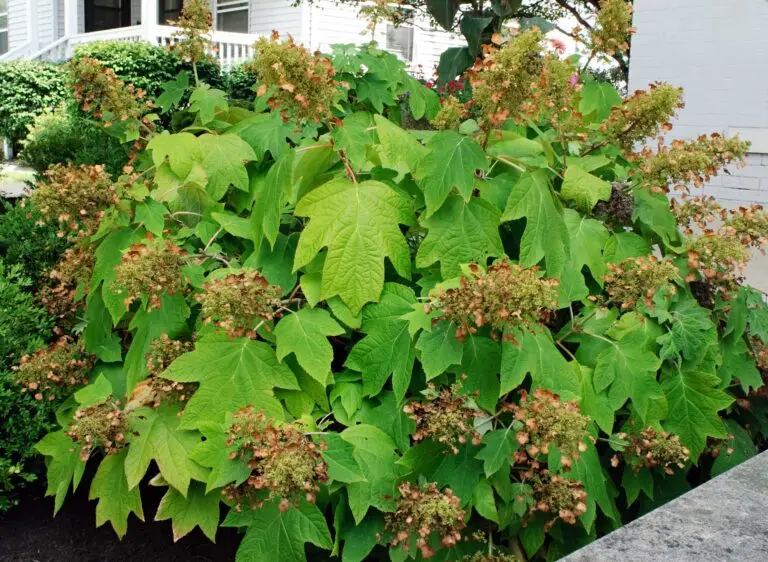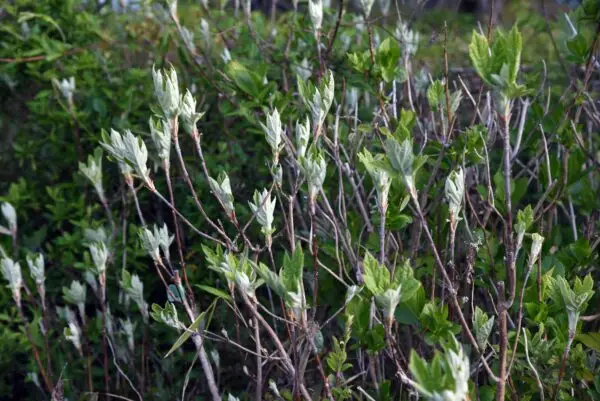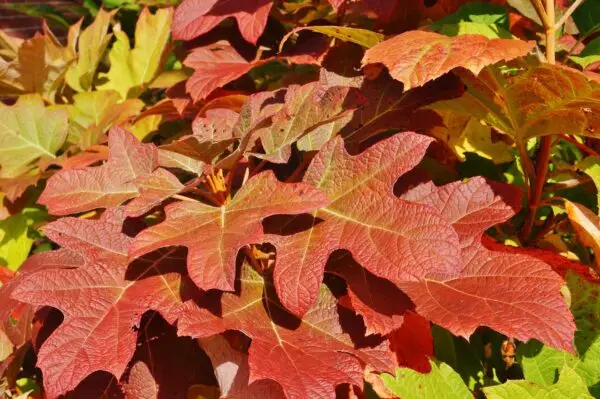Oakleaf Hydrangea
There are hundreds of species of hydrangeas worldwide. Only a few are native to North America, including Oakleaf Hydrangeas. These gorgeous shrubs deliver both memorable leaves and long-lasting flowers. In the fall, their leaves turn to shades of copper and fiery red. Many non-native hydrangeas can be finicky and require special care—but not the Oakleaf. Plant a few in sun or part-sun and enjoy beauty for years.
- Full Sun, Part Sun
- Medium Shrub (6-10')
- Summer flowers
- Amazing fall color

What are the benefits of planting an Oakleaf Hydrangea?
Oakleaf Hydrangeas are native plants, or plants that have lived in North America for thousands (if not millions) of years. The native plants in our areas have seen and survived every blizzard, heat wave, and drought in their home area. They have the DNA and experience to thrive in our gardens. Planting native is important for many reasons, including:
- Native plants like Oakleaf Hydrangeas give bugs, pollinators, and birds the homes and food they need to survive.
- Native plants and trees require minimal work, water, and care to thrive (especially compared to lawns.) After being established, all Oakleaf Hydrangeas need is rain to thrive.
- Native plants are GORGEOUS. They have been hiding in plain sight and their beauty is undeniable. Explore our library to find your faves.

Native vs. non-native hydrangeas
Hydrangeas are a go-to for landscaping. We really love them here in the U.S.—according to Penn State, 13.% of all shrubs sold in the U.S. in 2014 were hydrangeas. There are dozens of types to pick from, but the majority of the hydrangeas you see (with the round blue blooms) are native to Japan.
Non-native hydrangeas require lots of specialty care; plant an Oakleaf Hydrangea instead and save yourself time and money.
Non-native hydrangea care can be a pain
Martha Stewart’s non-native hydrangea recommendations include consistent moisture, checking the soil PH, and too much sun (or not enough!) On the other hand, Oakleaf Hydrangeas can handle periodic droughts and require no fertilizing.

Non-Native Hydrangeas
- Many non-native hydrangeas are from Asia
- Can require annoying extra care, including extra watering and finicky specialty fertilizers to get blue flowers
- Many are sterile, so they provide no nectar or pollen for native pollinators

Native Oakleaf Hydrangea
- Oakleaf Hydrangeas have grown for thousands of years in what is now the southeastern US
- They thrive in their home area; once they are established, Oakleaf Hydrangeas thrive with just rain
- Oakleaf Hydrangeas don’t need pruning
- Oakleaf Hydrangeas are stunning! Many people consider them the most beautiful shrub native to North America
Oakleaf Hydrangeas throughout the seasons
Oakleaf Hydrangeas transform themselves throughout the year. It is rewarding to fill our yards and parks with plants that change with the seasons. Their changes help enliven and surprise us, offering new vistas outside our windows every few months (as opposed to a boring boxwood evergreen shrub, which sits forever in its single, boring state.)

Spring
In the spring, bright green shoots emerge from the tips of branches. These first leaves look like green flowers! The leaves emerge from the cone over the spring, changing to a vibrant green.

Summer
Oakleaf Hydrangeas flowers last for MONTHS. After the leaves come the large, cone-shaped flowers. The blooms are large—bigger than your hand. Each provides lots of space for multiple pollinators.

Fall
In the fall, Oakleaf Hydrangea leaves turn into firey shades of copper and red. Because their leaves are so large, the effect is stunning. Plant them alongside some blue-purple asters for a perfect fall pairing.
What benefits does Oakleaf Hydrangea have for native wildlife?
Pollinators, including butterflies and bees, love Oakleaf Hydrangea flowers.
Interestingly, the bigger white flowers actually have no pollen or nectar: the smaller, less showy buds are the ones with the good stuff.
Native range
The Oakleaf Hydrangea is native to the southeastern United States, thriving in regions from Louisiana to Florida and as far north as Virginia. Due to climate change, Oakleaf Hydrangeas now grow in areas as far north as New York.
Where to plant Oakleaf Hydrangea
In the wild, Oakleaf hydrangeas are often found along streambeds. They like moist, rich soil like you’d find in a woodland, but once they’re established, they’re very hardy and surprisingly drought-tolerant.
They can grow in many soil types, including sand and clay, but they do not like to be waterlogged and will struggle in very wet spots.
In northern areas, they will happily grow in full sun to part shade, and will bloom better with more sun. In the South, they appreciate more shade and can light up dark corners of the garden.
Here’s a few ideas for where to plant Oakleaf Hydrangea:
- As a foundation plant along the front of your house
- As a four-season centerpiece in a border or island
- Against a wall or in front of evergreens, to appreciate their winter foliage
- As an informal hedge
- In the South, under shady trees to brighten up dark spots of the garden
- In woodland gardens or naturalized areas, under trees or along forest edges
How big does Oakleaf Hydrangea get?
Oakleaf hydrangea is a slow-growing but large shrub. It will grow 4-8 feet tall and 4-10 feet wide.
If that’s too big for your yard, there are “cultivars” (variations of the plant selected for special characteristics) that are smaller, such as ‘Pee Wee,’ which only grows to 4 feet by 3 feet.
What benefits does Oakleaf Hydrangea have for native wildlife?
Pollinators, including butterflies and bees, love Oakleaf Hydrangea flowers.
Interestingly, the bigger white flowers actually have no pollen or nectar: the smaller, less showy buds are the ones with the good stuff.
Native range
The Oakleaf Hydrangea is native to the southeastern United States, thriving in regions from Louisiana to Florida and as far north as Virginia. Due to climate change, Oakleaf Hydrangeas now grow in areas as far north as New York.
Where can I buy or source native Oakleaf Hydrangeas?
Hydrangeas are generally easy to find at almost any nursery in North America. Sadly, most of the hydrangeas you’ll see are the non-native variety.
To find a native Oakleaf, try exploring these four options:
Where can I find seeds and plants?
Finding native plants can be challenging (we partly blame Marie Antoinette.) To make it easier, we’ve assembled four sourcing ideas.
Native Nursery List
300+ native nurseries makes finding one a breeze
Online Native Plant Sellers
We've included 100+ online resources to help
Society Plant Sales
Every state has a native plant society; find yours
Online Communities
Local Facebook groups are a great plant source
What are good pairings for Oakleaf Hydrangeas?
These shrubs are best paired with other native plants that like similar partial sunlight. Trees like Sweetbay Magnolia and Tulip Poplar, shrubs like Mountain Laurel and Ninebark, and flowers like Aster and Bee Balm are great pairings.
Now you’re ready to plant an Oakleaf Hydrangea (or a few!) by using these tips and inspiration. Hydrangeas are known for being stunning yard additions—but only the Oakleaf Hydrangea is native to North America. Spend a morning planting this native shrub and watch it return decades of beauty, year-round. Want to meet some other native hydrangeas? Explore our Beginner’s Guide to Native Hydrangeas. Happy planting!
Sources
- Nelson, Gil. Best Native Plants for Southern Gardens: A Handbook for Gardeners, Homeowners, and Professionals, (2010).
- Harstad, Carolyn. Go Native! Gardening with Native Plants and Wildflowers in the Lower Midwest. (1999).
- Penn State Extension, “Wild Hydrangeas.”
- North Carolina Extension, Hydrangea quercifolia (Oak Leaf Hydrangea, Oakleaf Hydrangea).
- Master Gardeners of Northern Virginia, Hydrangea quercifolia (Oakleaf Hydrangea).
- Batchelor, Dale. “Oakleaf Hydrangea: Queen of the Shade.” Triangle Gardener Magazine.























